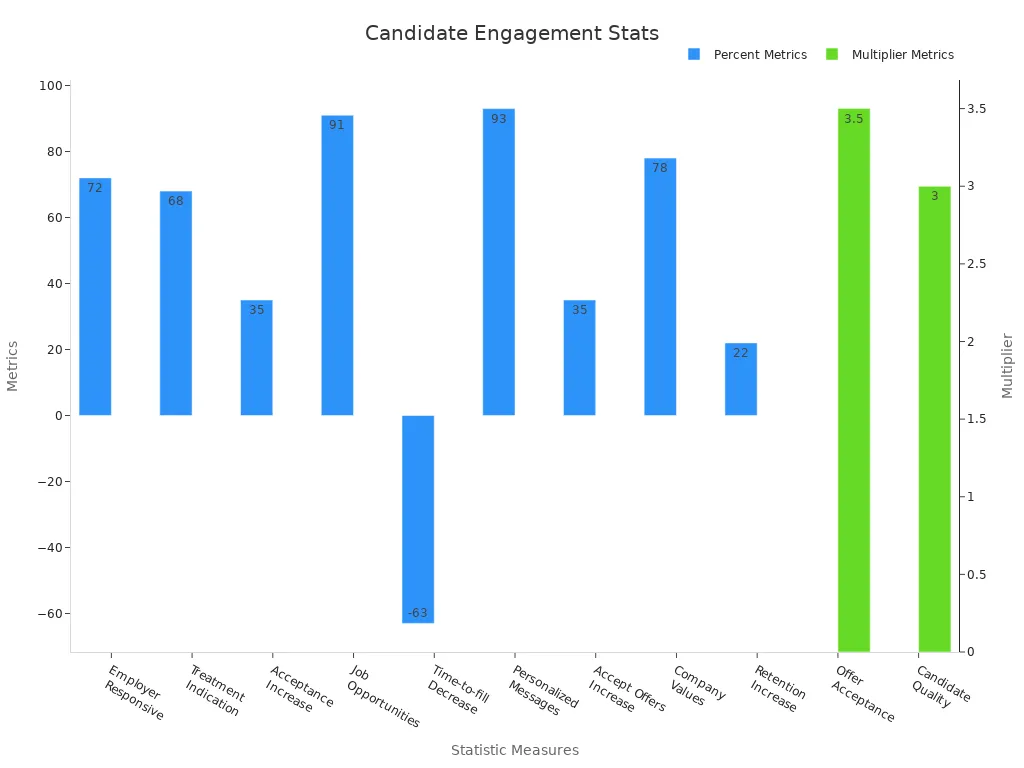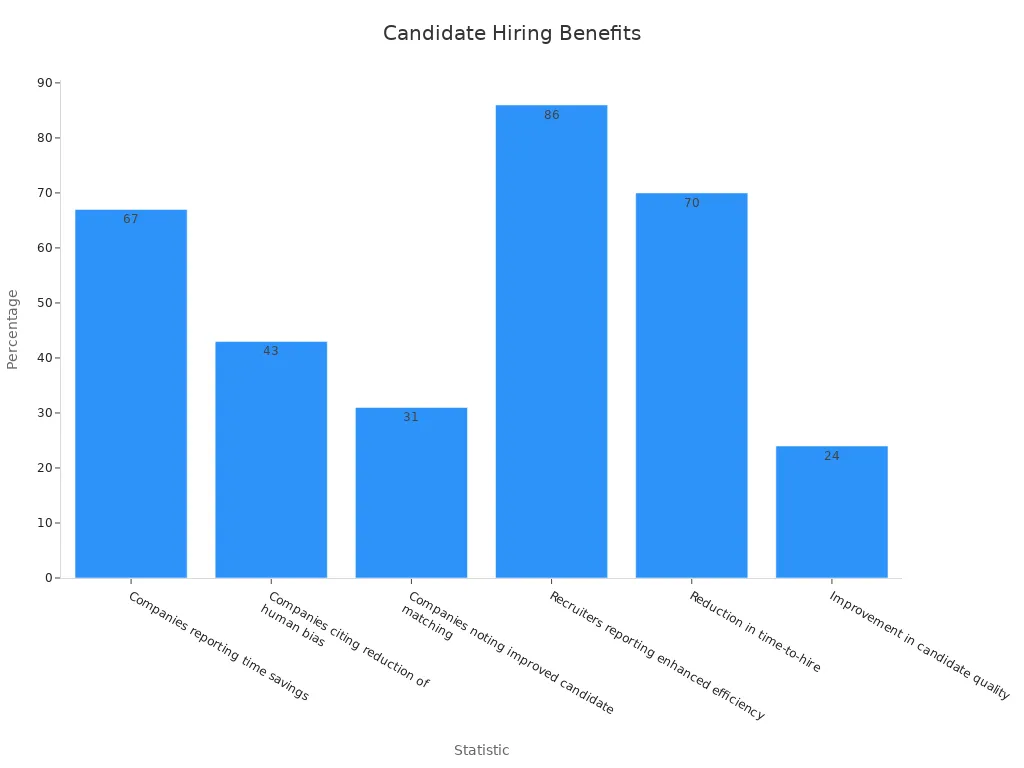What is Candidate-Centric Hiring and Why It Matters

Candidate-centric hiring focuses on creating a recruitment process that values your experience, needs, and preferences. Unlike traditional methods, which often prioritize employer demands, this approach ensures you feel respected and engaged throughout the hiring journey. It tackles common issues like unclear communication, lengthy processes, and impersonal interactions. By putting you at the center, candidate-centric hiring improves outcomes for both job seekers and employers. It builds trust, enhances satisfaction, and fosters better matches between candidates and roles.
Key Takeaways
Candidate-focused hiring puts job seekers first with a kind process.
This method makes candidates happier and improves the company’s image.
Making applications simple and talking more keeps candidates interested.
Tools like chatbots and AI speed up hiring and lower unfairness.
Asking candidates for feedback helps fix hiring and builds trust.
Understanding Candidate-Centric Hiring
What is candidate-centric hiring?
Candidate-centric hiring is a recruitment strategy that puts job seekers at the heart of the hiring process. Instead of focusing solely on the employer's needs, this approach prioritizes the candidate's experience, preferences, and expectations. It ensures that every step of the hiring journey, from application to onboarding, is designed to make candidates feel valued and respected.
This method offers several advantages:
It creates a positive experience for candidates, even if they are not selected.
It enhances the organization's reputation, making it more attractive to top talent.
It improves the quality of hires, as candidates are more likely to accept offers from companies that treat them well.
It reduces the time and cost of hiring by streamlining processes and fostering trust.
For example, companies like Apple and Microsoft have successfully implemented candidate-centric hiring strategies. Apple focused on cultural fit when recruiting Tim Cook, while Microsoft conducted a global search for a CEO, ultimately appointing Satya Nadella. Both cases highlight how prioritizing candidates' needs can lead to long-term success.
Core principles of candidate-centric hiring
Candidate-centric hiring revolves around several key principles:
Empathy and respect: Treat candidates as individuals, not just applicants. Understand their needs and provide clear communication throughout the process.
Transparency: Share detailed information about the role, company culture, and hiring timeline. Candidates appreciate honesty and clarity.
Efficiency: Simplify the application process and reduce unnecessary delays. A smooth process saves time for both candidates and recruiters.
Personalization: Tailor interactions to each candidate. For instance, address them by name and acknowledge their unique skills and experiences.
Feedback: Collect feedback from candidates about their experience and use it to improve future hiring efforts.
Research shows that nearly 50% of candidates will not support a business after a negative recruiting experience. By adopting these principles, you can create a hiring process that attracts top talent, reduces turnover, and strengthens your employer brand.
Candidate-Centric Hiring vs. Traditional Hiring
Defining traditional (employer-centric) hiring
Traditional hiring, often referred to as employer-centric hiring, focuses on meeting the immediate needs of the organization. This approach prioritizes filling vacancies quickly, often overlooking the candidate's experience or long-term potential. Employers typically rely on resumes and interviews to assess candidates, which can lead to challenges in evaluating skills and accuracy.
A study revealed that 43% of employers struggle to rank candidates using resumes, while 51% find it difficult to verify their accuracy. This method often results in a reactive process, starting only when a position becomes available, and limits engagement with potential hires until interviews begin.
Key differences between the two approaches
Candidate-centric hiring and traditional hiring differ significantly in their strategies and outcomes. The table below highlights these differences:
Aspect | Traditional Recruitment Approach | |
|---|---|---|
Proactive vs. Reactive | Focuses on building relationships before roles open | Begins when there's an immediate need |
Long-term vs. Short-term | Aims for a sustainable talent pool | Prioritizes filling current vacancies |
Engagement Strategy | Continuous engagement with potential hires | Limited interaction until interviews |
Relies on analytics for forecasting needs | Less emphasis on data-driven methods | |
Cost-Effectiveness | Can reduce hiring costs by up to 30% | Generally higher hiring costs |
Quality of Hire | 25% higher retention rate reported | Lower retention rates among hires |
This comparison shows how candidate-centric hiring fosters better outcomes for both employers and job seekers.
Why organizations are shifting to candidate-centric hiring
Organizations are increasingly adopting candidate-centric hiring to meet the expectations of modern job seekers. Today’s candidates value personalized experiences, flexible work arrangements, and alignment with company culture. Generic job postings no longer attract top talent.
Additionally, emphasizing quality in hiring practices enhances operational effectiveness and strengthens an employer's reputation. The chart below illustrates how skills-based hiring, a key component of candidate-centric hiring, outperforms traditional methods:
By shifting to candidate-centric hiring, you can build a sustainable talent pool, reduce costs, and improve retention rates.
Benefits of Candidate-Centric Hiring

Improved candidate experience and satisfaction
Candidate-centric hiring transforms the way job seekers perceive your organization. By focusing on their needs, you create a smoother and more engaging recruitment process. Candidates appreciate clear communication, timely updates, and a respectful approach. These elements significantly enhance their overall experience.
A poor hiring experience can lead to missed opportunities. For example, 52% of job seekers reject offers due to negative experiences during recruitment. On the other hand, organizations that prioritize candidate satisfaction see measurable improvements. The table below highlights how Net Promoter Scores (NPS) improved for companies adopting candidate-centric practices:
NPS Type | 2023 Score | 2024 Score | Improvement |
|---|---|---|---|
Overall NPS | 55.7 | 63.2 | +7.5 |
External NPS | 56.1 | 63 | +6.9 |
Internal NPS | 41.1 | 66.9 | +25.8 |
These numbers show how a candidate-focused approach can elevate satisfaction and loyalty.
Stronger employer branding and reputation
Your hiring process reflects your company’s values. A candidate-centric approach strengthens your employer brand by showcasing your commitment to people. When candidates feel valued, they are more likely to speak positively about your organization, even if they don’t get the job.
Recent data shows that 81% of companies have taken steps to improve their employer brand in the past year. Offering flexible working opportunities is one of the most popular initiatives. These efforts not only attract top talent but also position your company as a desirable place to work. A strong employer brand gives you a competitive edge in today’s job market.
Higher quality of hires and retention rates
Candidate-centric hiring doesn’t just improve the experience—it also leads to better hiring outcomes. When you focus on aligning candidates’ skills and values with your organization, you’re more likely to find the right fit. This approach reduces turnover and boosts employee performance.
The table below outlines key metrics that connect candidate-centric hiring with higher-quality hires:
Metric | Description |
|---|---|
Retention Rates | Percentage of new hires who stay with the company after a year. |
Performance Ratings | Evaluation of new hires' performance after 6-12 months. |
Hiring Manager Satisfaction | Feedback from hiring managers on new hires' performance. |
By prioritizing candidates’ needs, you not only attract top talent but also ensure they thrive in their roles. This results in long-term success for both your employees and your organization.
Competitive edge in attracting top talent
In today’s competitive job market, attracting top talent requires more than just offering a paycheck. The best candidates look for workplaces that align with their values and provide opportunities for growth. Candidate-centric hiring gives you a significant advantage by addressing these priorities directly.
Modern employees value flexibility, a positive work culture, and clear career paths. They want to work for companies that care about their well-being and offer transparent opportunities for personal and professional development. By focusing on these aspects, you can position your organization as a desirable place to work. This approach not only attracts top talent but also ensures they remain engaged and motivated.
Research shows that 59% of European employers struggle to find qualified candidates for open positions. This highlights the importance of standing out in a crowded job market. A strong recruitment process, built on candidate-centric hiring principles, helps you differentiate your organization. It demonstrates your commitment to creating a supportive and forward-thinking workplace.
Top candidates often gravitate toward companies with innovative cultures and values. They seek more than financial compensation—they want to feel valued and respected. By adopting a candidate-centric approach, you show that your organization prioritizes people. This reputation can make all the difference when competing for the best talent.
Ultimately, candidate-centric hiring not only helps you attract skilled professionals but also builds a workforce that aligns with your company’s goals. It’s a strategy that benefits both your organization and the individuals who join it.
How to Implement Candidate-Centric Hiring

Simplify the application process
A streamlined application process is the foundation of Candidate-Centric Hiring. Simplifying this step reduces barriers for job seekers and ensures a positive first impression. Start by eliminating unnecessary steps and focusing on essential information. For example, McDonald's introduced a voice-activated job search system, allowing candidates to apply using voice commands. This innovation reduced the time from application to hire and demonstrated how technology can simplify recruitment.
You can also optimize your application forms for mobile devices. Many candidates prefer applying on their phones, so a mobile-friendly interface can significantly improve their experience. Additionally, provide clear instructions and avoid asking for redundant information. A simple, user-friendly process encourages more candidates to complete their applications.
Enhance communication and transparency
Effective communication and transparency build trust with candidates. Keep them informed at every stage of the hiring process. Share updates about their application status and provide realistic timelines for next steps. This approach not only reduces anxiety but also shows respect for their time.
Metrics like time-to-hire and cost-per-hire highlight the benefits of improved communication. A shorter time-to-hire reflects an efficient process, while a lower cost-per-hire indicates better resource management. By prioritizing transparency, you create a recruitment experience that candidates appreciate and remember.
Personalize the candidate experience
Personalization is a key element of Candidate-Centric Hiring. Tailor your interactions to each candidate’s preferences and needs. Use their name in communications, acknowledge their unique skills, and provide relevant information about the role. Personalized strategies have been shown to increase candidate engagement and acceptance rates.
For instance, 72% of candidates believe employer responsiveness influences their decision-making. Additionally, 35% of candidates are more likely to accept offers when the recruitment process feels personalized. The chart below illustrates the impact of personalization on candidate engagement:

By focusing on personalization, you not only attract top talent but also foster a positive perception of your organization. This approach demonstrates your commitment to valuing individuals, which strengthens your employer brand.
Use technology to improve efficiency
Technology plays a vital role in streamlining the hiring process. By integrating advanced tools, you can save time, reduce errors, and create a seamless experience for candidates. Here are some innovations that can transform your recruitment efforts:
AI Interview Platforms: These platforms automate initial interviews, allowing you to assess candidates faster. They also provide a consistent and unbiased evaluation, which improves the overall hiring process.
Chatbots: Chatbots engage candidates instantly by answering questions and guiding them through the application process. This reduces drop-offs and increases the number of completed applications.
Data Analytics: Analytics tools offer valuable insights into hiring trends and candidate behavior. They help you make informed decisions, ensuring you select the best talent for your organization.
Using these technologies not only enhances efficiency but also improves the candidate experience. For example, chatbots provide immediate responses, which candidates appreciate. AI tools reduce waiting times, making the process smoother. By adopting these solutions, you can stay ahead in the competitive job market.
Tip: Start small by implementing one tool, such as a chatbot, and gradually expand your tech stack as you see results.
Collect and act on candidate feedback
Feedback is a powerful tool for improving your hiring process. Candidates’ opinions reveal what works well and what needs adjustment. Listening to their experiences helps you create a more effective and candidate-friendly recruitment strategy.
Studies show that 60% of candidates have faced poor experiences during hiring. Many of them share these negative experiences with others, which can harm your company’s reputation. Additionally, a bad experience makes candidates less likely to engage with your brand in the future.
By collecting feedback, you can:
Understand candidates’ preferences and expectations.
Identify trends in recruitment and adjust your strategies.
Improve communication with candidates who were not selected.
Design better onboarding plans for new hires.
Acting on feedback demonstrates that you value candidates’ input. For example, if candidates mention delays in communication, you can implement updates to keep them informed. This not only enhances their experience but also strengthens your employer brand.
Note: Use surveys or follow-up emails to gather feedback. Keep the process simple and ensure candidates feel comfortable sharing their thoughts.
Why Candidate-Centric Hiring Matters
Long-term impact on recruitment success
Candidate-Centric Hiring creates a foundation for sustainable recruitment success. By prioritizing the candidate's experience, you build trust and foster positive relationships. This approach ensures that even candidates who are not selected leave with a favorable impression of your organization. A strong reputation attracts top talent and reduces the time and cost of future hiring efforts.
Several factors influence the candidate experience, including ease of application, communication quality, and feedback access. Companies that measure and improve these aspects see significant benefits:
69% of candidates consider a company's reputation when deciding to accept a job offer.
Organizations focusing on candidate experience are 70% more likely to enhance the quality of their hires.
By investing in a candidate-centric approach, you not only improve hiring outcomes but also strengthen your employer brand for long-term success.
Meeting modern workforce expectations
Today’s workforce expects more from employers. Candidates value diversity, inclusion, and streamlined hiring processes. They also seek positive experiences that reflect a company’s commitment to fairness and innovation. Meeting these expectations is essential for attracting and retaining top talent.
Modern tools can help you achieve these goals. For example:
Technology can eliminate bias in recruitment, supporting diversity and inclusion.
Tools that anonymize candidate profiles promote fairness and help build inclusive teams.
A diverse workforce offers a competitive advantage. It attracts candidates with unique skills and fosters creativity and innovation. By aligning your hiring practices with these expectations, you position your organization as a forward-thinking employer.
Building a sustainable and inclusive hiring strategy
Sustainability and inclusiveness are key to long-term recruitment success. A sustainable hiring strategy evaluates candidates not only for their skills but also for their passion for social and environmental challenges. Inclusiveness ensures that diverse candidates feel valued and supported throughout the hiring process.
Metrics play a crucial role in assessing these efforts:
Metric Type | Description |
|---|---|
Alignment with Sustainability Goals | Recruitment processes evaluate candidates' passion for social and environmental challenges. |
Diversity Tracking | Measure the number of candidates from diverse backgrounds and their progression through hiring stages. |
Onboarding Support | Assess the support provided to remote employees to ensure they feel included in the organization. |
By tracking these metrics, you can create a hiring process that aligns with your organization's values. This approach not only attracts top talent but also builds a workforce that drives innovation and growth.
Candidate-Centric Hiring plays a vital role in today’s competitive job market. By focusing on the candidate's experience, you can create a recruitment process that attracts top talent and builds lasting relationships. This approach benefits both candidates and employers by improving satisfaction, reducing hiring time, and enhancing the quality of hires.
The statistics below highlight the transformative impact of adopting this strategy:
Statistic Description | Percentage |
|---|---|
Companies reporting time savings | 67% |
Companies citing reduction of human bias | 43% |
Companies noting improved candidate matching | 31% |
Recruiters reporting enhanced efficiency | 86% |
Reduction in time-to-hire | Up to 70% |
Improvement in candidate quality | 24% |

Adopting this approach ensures long-term recruitment success. It aligns your hiring practices with modern workforce expectations and strengthens your employer brand. By prioritizing candidates, you not only meet their needs but also position your organization as a leader in innovation and inclusivity.
FAQ
What is the main goal of candidate-centric hiring?
The main goal is to prioritize the candidate's experience during the hiring process. This approach ensures you feel valued, respected, and engaged, leading to better matches between candidates and roles. It also helps organizations attract and retain top talent.
How does candidate-centric hiring improve retention rates?
By focusing on aligning your skills, values, and goals with the company, this approach ensures a better fit. Employees who feel valued and aligned with their workplace are more likely to stay, reducing turnover and improving retention rates.
What role does technology play in candidate-centric hiring?
Technology simplifies and enhances the hiring process. Tools like AI interview platforms, chatbots, and data analytics improve efficiency, reduce bias, and create a seamless experience for you. These innovations save time and make the process more engaging.
Why is feedback important in candidate-centric hiring?
Feedback helps organizations understand your experience and identify areas for improvement. By acting on your input, companies can create a more effective and respectful hiring process. This builds trust and strengthens their employer brand.
Can small businesses adopt candidate-centric hiring?
Yes! Small businesses can implement this approach by simplifying applications, personalizing communication, and using affordable tools like chatbots. Even small changes can make a big difference in creating a positive candidate experience.
Tip: Start with one improvement, like enhancing communication, and build from there.
See Also
Understanding Candidate Relationship Management Software Solutions
Utilizing AI For Fair And Impartial Hiring Processes
Applicant Tracking Systems: Identifying Top Talent Effectively
Boosting Recruitment Clarity With Applicant Tracking Systems
Important Factors To Consider For Applicant Tracking Systems
From recruiting candidates to onboarding new team members, MokaHR gives your company everything you need to be great at hiring.
Subscribe for more information

